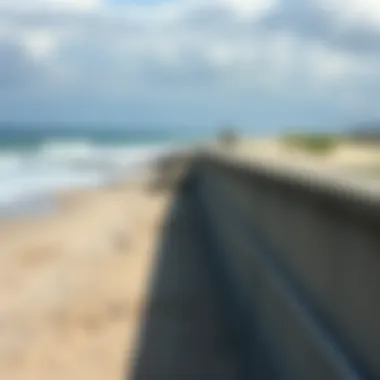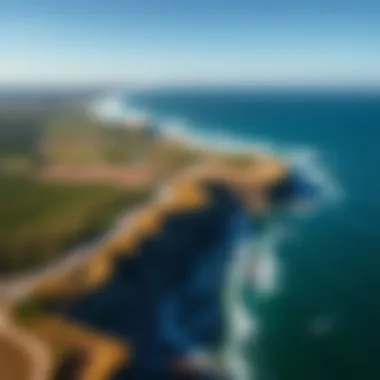Shoreline Seawalls: Essential Coastal Protection Strategies


Intro
Coastal areas are under constant threat, faced with the relentless power of waves and rising sea levels. Amidst this backdrop, shoreline seawalls have emerged as a critical line of defense. Their primary objective is to shield the coast from erosion, a process that often leads to loss of land and affects local communities. In exploring this dynamic field, it’s essential to understand the various types of seawalls, their construction methods, and the far-reaching implications they hold for both the environment and local cultures, especially surf culture.
Seawalls serve as a physical barrier designed to protect shorelines from the impact of storms and tides. While they are undeniably effective, their presence also raises questions regarding ecological balance and long-term sustainability. Recent advancements in seawall technology offer promising solutions, blending traditional construction methods with innovative approaches to minimize environmental disruption. Surfers, often the unspoken guardians of ocean health, find themselves at the intersection of these discussions—navigating the delicate balance between enjoying their beloved waves and recognizing the significance of coastal protection.
As we dig deeper into this topic, we’ll explore the evolution of seawall designs, their pros and cons, and their evolving role in safeguarding coastlines. Plus, we’ll touch on the importance of preserving the surfing landscape against the challenges posed by environmental changes. This knowledge is not just for scientists or policy makers; it speaks directly to surfers, sports enthusiasts, and anyone who values the vibrant life along our shores.
Preamble to Shoreline Seawalls
Coastal areas, with their breathtaking vistas and vibrant ecosystems, are under constant threat from erosion. The loss of sand and soil can transform the landscape dramatically, impacting habitats, properties, and recreational spaces. Shoreline seawalls emerge as a vital solution for protecting these coastlines, acting as barriers against the relentless forces of nature.
Seawalls are more than mere structures; they embody a converging point for environmental engineering, scenic conservation, and community sustainability. They serve not only to safeguard marine environments but also to preserve the lifestyles of those who inhabit and enjoy these coastal regions. As the tides shift and storms intensify, understanding the role of seawalls is essential for both coastal dwellers and surfers alike.
The discussion in this article will unravel the definition and purpose of seawalls, explore their historical context, and highlight how they have evolved over time. Such insights not only address the practical elements involved in coastal management but also delve into the intricate relationship between seawalls and the local culture.
Being well-versed in these topics is crucial for current and future generations. As the seas rise and weather patterns continue to challenge our coastlines, the implications for surfers, environmental advocates, and general public are profound. It’s not merely about solid engineering — it’s about advocating for a more balanced coexistence between human activity and nature’s whims.
"To protect our beaches is to safeguard the very essence of coastal life. Without seawalls, we risk losing not just our homes but our connection to the surf and the shore."
As such, this article aims to be an eye-opener, not just on the technical details but on the cultural significance these structures hold. With a thoughtful examination of seawalls, we aim to arm the audience, from surfers to environmentalists, with the knowledge to engage in this critical discourse.
Types of Seawalls
Understanding the various types of seawalls is fundamental when discussing coastal protection. Each design has its own unique features, functions, and situations where it performs best. Choosing the right type of seawall is crucial as it affects both the ecological balance and the effectiveness in curbing erosion. Here, we will explore four dominant types of seawalls that are often employed along coastlines, delving into their specific characteristics and implications for coastal management.
Vertical Seawalls
Vertical seawalls are perhaps the most recognizable type of coastal barrier. These structures rise sharply from the beach and are designed to deflect waves. Their straight face allows for water to hit and reflect back without losing energy. This type makes a primarily solid interface between the land and sea.
Benefits:
- Space-efficient: They occupy less beach area compared to sloped options.
- Durability: Constructed from materials like concrete or stone, they often have long lifespans.
Considerations:
- Wave pressure: The sheer vertical contact may lead to increased scour at the base, necessitating regular maintenance.
- Wildlife impact: They can disrupt natural habitats, making it difficult for creatures like crabs and turtles to navigate.
Curved Seawalls
Curved seawalls, as the name suggests, feature a curved design that helps to minimize wave energy more effectively than their vertical counterparts. The shape allows the impact of waves to be transmitted along the structure and reduces the energy that reaches the base.
Benefits:
- Wave energy diffusion: The curve redirects waves back into the ocean, which helps to limit erosion along the coastline.
- Aesthetics: Often seen as more visually appealing, these walls can blend more naturally into coastal environments.
Considerations:
- Cost: Their design and construction can often be more expensive due to complexity.
- Engineering demands: Requires precise calculations and construction techniques, making it crucial to have skilled engineers involved.
Reinforced Concrete Seawalls
Reinforced concrete seawalls are a robust option, amalgamating concrete with steel reinforcements to enhance resilience against harsh weather. These seawalls can take many forms, including vertical and curved designs, but the focus is on strength.
Benefits:
- High strength: Capable of withstanding significant forces, making them suitable for high-energy coastlines.
- Longevity: Properly maintained, they can last decades, unlike wood or other less durable materials.
Considerations:
- Environmental concerns: Concrete can lead to increased heat and runoff, potentially affecting nearby marine habitats.
- Cost: The initial investment is higher compared to other materials, which may deter some coastal managers.
Natural Alternatives
In recent years, there has been a notable push toward natural alternatives that serve to protect coastlines while promoting ecological health. These include living shorelines and other green infrastructure systems, which utilize natural elements such as vegetation and sediment.
Benefits:
- Eco-friendly: They enhance biodiversity and provide habitats for marine life, making them a favorite among environmental advocates.
- Cost-efficient: Over time, these systems can be more budget-friendly as they often require less maintenance than hard structures.
Considerations:


- Effectiveness: Their ability to resist severe wave actions can sometimes be less effective than hard structures.
- Space requirements: Natural systems often require more space, which can be a limitation in densely populated areas.
Through understanding these types of seawalls, we can appreciate the diverse approaches to managing coastal erosion. Each type has its specific utility, balancing the needs of coastal communities with the demands of environmental sustainability.
Construction Methods
The construction methods employed in building seawalls are crucial not just for their effectiveness, but also for ensuring their longevity and environmental compatibility. Proper construction ensures that these barriers can withstand the rigorous forces of nature, effectively protecting coastlines from the relentless erosion caused by waves and tides. As the landscape of coastal management evolves, understanding how seawalls are constructed helps in appreciating their role in creating sustainable environments for both human activity and natural habitats.
Materials Used
When it comes to the materials used in seawall construction, the choice can make or break the structure's performance. Here are the common materials:
- Reinforced Concrete: This is a staple in seawall projects due to its strength and durability. Reinforced concrete can withstand aggressive marine conditions and has a long lifespan.
- Gypsum: An interesting alternative, gypsum can be used in specific geographic areas where it’s abundant. Its natural properties make it suitable for interfacing with marine environments while being cost-effective.
- Boulders and Riprap: This method involves using large stones to create a barrier. The beauty of this material is its ability to mimic natural coastlines, which helps maintain local ecosystems while offering effective erosion control.
- Geotextiles: Made from synthetic fibers, geotextiles provide a supportive structure, allowing for better water drainage and reducing the pressure on walls. They are particularly useful in areas where soil erosion is a significant concern.
The selection of materials depends largely on factors such as local environmental conditions, expected wave action, and budgets. For example, while reinforced concrete may be optimal for high-impact zones, geotextiles could offer a more eco-friendly solution in less turbulent waters.
Engineering Techniques
Effective engineering techniques are just as essential as the materials used. It’s about coming up with innovative designs that adapt to the surrounding environment. Here are some notable engineering methods:
- Gravity Walls: This design relies on the weight of the wall itself to resist lateral forces from soil and water. They are often made from concrete blocks or stones.
- Cantilever Walls: These seawalls are designed with a large base to support the structure and prevent tipping over. Their design allows for greater flexibility in terms of height and angle, making them suitable for various coastal terrains.
- Sheet Piling: This involves driving long, thin sheets of steel or other materials into the ground to create a barrier. Sheet piling works best in softer soils and is often used in urban coastal areas where traditional methods may not be feasible.
- Flexible Seawalls: Crafted from materials that can deform under pressure, these walls absorb shock and reduce stress on the shoreline. This flexibility is particularly beneficial in areas where environmental factors are unpredictable.
By investing in innovative engineering techniques and durable materials, we not only protect our coastlines better but also contribute to the overall health of coastal ecosystems.
In summary, the construction methods employed in building seawalls are vital to their functional life, resilience against natural forces, and interaction with local environments. Making informed choices on materials and techniques can lead to not just effective erosion control but a more harmonious relationship between human infrastructure and marine ecosystems.
Coastal Erosion and Its Impacts
Coastal erosion is not just a natural process; it's a significant environmental challenge that impacts landscapes, ecosystems, and communities. Understanding the dynamics of coastal erosion is vital, especially in the context of seawall effectiveness. The coastlines where surfers enjoy their craft are often the very areas feeling the brunt of erosion's effects. As sands shift and shorelines change, we must grasp not only the causes but the consequences tied to these phenomena.
Causes of Coastal Erosion
Coastal erosion springs from a mixture of natural and human-induced factors. Some major causes include:
- Wave Action: The ocean's relentless waves can wear down rocks and sediments, leading to significant erosion.
- Storm Surges: Extreme weather events can dramatically change the shoreline's shape, often pulling large amounts of sand away from the beach.
- Sea Level Rise: Due to climate change, rising sea levels are encroaching on land, exacerbating erosion.
- Human Activities: Construction, dredging, and removal of vegetation can destabilize coastlines and contribute to their deterioration.
Understanding these causes helps coastal communities and surfers alike position themselves more effectively against the perils of erosion.
Consequences for Coastal Communities
The effects of coastal erosion ripple throughout various aspects of coastal life. Key consequences include:
- Loss of Land: Homes and businesses along the coast can be at risk. It’s alarming to realize that some beachfront properties may be deemed uninhabitable before long.
- Economic Impact: The tourism industry often relies on the appeal of vibrant beaches. When beaches erode, local economies may face dire consequences.
- Habitat Destruction: Erosion can eliminate crucial habitats for marine and bird species, disrupting the delicate balance of these ecosystems.
- Increased Flood Risk: As shorelines retreat, inland areas may face greater flood risks during storms, which can endanger lives and property.
"Coastal erosion is not just about losing sand; it’s about the communities that depend on that sand for their livelihood and recreation."
The urgency surrounding coastal erosion is palpable. Its consequences extend beyond environmental concerns, intertwining with the social fabric of coastal living. With such consequences at stake, engaging in seawall construction and maintenance becomes a compelling option as we look for ways to mitigate the relentless advancements of the tides.
Environmental Considerations
Understanding the environmental aspects surrounding shoreline seawalls is not just an afterthought—it's a necessity. These structures serve to protect coastlines from erosion and storm surge, but they can also have far-reaching implications for marine ecosystems and coastal habitats. When we talk about seawalls, we're not just discussing concrete and steel; we have to consider how they interplay with nature. This section delves into the effects that seawalls can have on marine ecosystems and the regulatory frameworks put in place to mitigate their impact.
Effects on Marine Ecosystems
Seawalls can be a double-edged sword when it comes to marine life. On one hand, they provide immediate protection to human settlements, but they can also disrupt the natural habitats that exist right up to the shoreline. Here are some critical points to consider:
- Alteration of habitats: Seawalls create a rigid boundary between land and sea, which may displace species that thrive in sandy or rocky shorelines. By changing the shape and structure of coastal environments, these barriers can push marine organisms to less suitable areas.
- Sediment transport: The presence of a seawall can affect how sediments move along the coast. This is especially important for beach-nesting birds and other wildlife that rely on specific sediment types for breeding and foraging. When sediment flow is interrupted, it can hinder the natural replenishment of beaches, putting these species at risk.
- Habitat loss: Some species rely on intertidal zones—areas that are altered or lost when seawalls are constructed. Without these critical zones, populations of crustaceans, mollusks, and other marine organisms can face significant declines.
“Seawalls may protect us, but at what cost to the ecosystems that surround us?”
Considering these impacts is essential for any long-term coastal management strategy. Without thoughtful designs that incorporate ecological sensitivity, we may find ourselves trapped in a cycle of environmental degradation while trying to secure our coastlines against nature’s relentless forces.
Regulatory Frameworks
The regulatory framework surrounding seawalls varies widely but generally aims to strike a balance between human needs and environmental conservation. Effective legislation often takes several forms:
- Environmental assessments: Before any seawall construction begins, many jurisdictions require comprehensive impact assessments to evaluate how the project will affect coastal ecosystems. These assessments can inform design modifications that might reduce negative outcomes for local wildlife.
- Permitting processes: Obtaining the necessary permits isn't just a formality; it's a critical step to ensure that the design and construction of seawalls comply with environmental standards. Regulatory agencies often involve marine biologists and ecologists in the review process to gauge potential impacts.
- Mitigation strategies: Some frameworks require that developers put measures in place to mitigate harm to marine ecosystems. This can include creating artificial reefs, restoring coastal wetlands, or investing in research and monitoring to better understand both current and future impacts.
In summary, the intersection of seawalls and the environment is complex and multi-faceted. Developing an in-depth knowledge of their effects on marine ecosystems and understanding the regulatory frameworks surrounding their construction and utilization is paramount. Careful planning, active engagement with local communities, and adherence to regulations can lead to better outcomes—not just for human settlements but for the aquatic life that is an integral part of coastal environments.
Seawalls and Surf Culture


The interaction between seawalls and surf culture is a nuanced topic that often goes unexamined in both coastal management discussions and surf communities. Many surfers see seawalls primarily as hindrances to their beloved breaks, while coastal managers might consider them vital structures for protection against erosion. This section delves into how seawalls are woven into the fabric of surfing, influencing not only the physical landscape but also the surf culture itself.
Impact on Surf Breaks
Seawalls can significantly alter the dynamics of surf breaks. Depending on their design and placement, these structures may improve, diminish, or completely change the waves that reach surfers. For instance, vertical seawalls may create steepened waves, providing thrilling rides for seasoned surfers, while simultaneously making it harder for novice surfers to navigate their way into the lineup. The effects on surf breaks can be mixed, with some regions experiencing enhanced wave quality and others suffering from poor formations.
Consider the famed Trestles in California; the presence of a seawall has been shown to influence how swells wrap around the cove and break. As a result, surfers have had to rethink their strategies, adapting to ways that a seawall transforms the ocean conditions.
"Seawalls are like a double-edged sword; they protect the shore but can also alter the waves we ride."
The strategic placement of seawalls is crucial. Some argue that thoughtful engineering can mitigate negative impacts by enhancing sand retention, which supports better surfing conditions. When a seawall is effective in preventing erosion, it allows for a more stable beach which benefits surfing accessibility.
Cultural Significance
Beyond the physical effects on surf breaks, seawalls carve out a significant role in the cultural identity of coastal communities. They become symbols, often serving as landmarks and gathering spots for surfers and beachgoers.
In places like Waikiki, Hawaii, the seawall is part of the landscape that reflects the balance of nature and human intervention. It encapsulates the ongoing dialogue about whether we can or should meddle with coastal ecosystems. For surfers, these structures evoke a sense of belonging and permanence, grounding them in their passion for the ocean.
Moreover, seawalls can become focal points during community discussions on coastal resilience. Events such as surf competitions or beach clean-ups often happen in proximity to these structures, nurturing community ties while raising awareness about the challenges that coastlines face.
There's a story associated with every break, and seawalls bring their share of history into play. They can remind surfers of past storms and how communities rallied resilience, or they can embody frustrations regarding access to prime surf locations.
As surf schools proliferate along coastal areas reinforced with seawalls, there's an opportunity to foster a deep respect for the sea among new surfers. They learn not only to ride waves but to appreciate the delicate balance between human structures and nature's power. This reverence could bridge the gap between surf culture and the management strategies of coastal preservation, creating a community that's both aware and involved.
In summary, seawalls impact surf culture beyond their immediate physical presence. They shape the surfing experience and serve as cultural touchstones that highlight the intersection of protection and tradition. The ongoing dialogue about how we manage our coastlines will determine how these two worlds coexist in the future.
Case Studies of Seawall Implementation
Examining real-world cases of seawall implementation offers valuable insights into both their effectiveness and challenges. By exploring various projects, we can understand not just the technical aspects of seawalls but also their social, environmental, and economic implications. Case studies serve as crucial building blocks for future shoreline management efforts, highlighting what can be learned from both triumphant successes and sobering failures.
Successful Interventions
One notable example of a successful seawall project is the Huntington Beach Seawall in California. This wall was constructed to combat severe erosion caused by strong waves, particularly during winter storms. Over the decades, the seawall has demonstrated its impact by not only protecting the beachfront properties but also maintaining public access for recreational activities such as surfing and beach volleyball.
- Key Indicators of Success:
- The seawall significantly reduced property damage during heavy storms.
- It has facilitated continuous community events without interruption from coastal erosion issues.
- Provides a stable base for future enhancements, such as adding more recreational space for beachgoers.
Another case worth noting is in the Miami Beach area, where the construction of a multi-million dollar seawall project has risen to meet changing sea level dynamics. Here, the seawall utilizes innovative materials designed to withstand the unique challenges posed by saltwater corrosion.
"With rising sea levels and increased storm frequency, these seawalls aren’t just barriers; they are lifelines for coastal communities facing uncertain futures."
Lessons from Failures
However, not all seawall projects have flourished. The New Jersey seawall that was built post-Hurricane Sandy serves as a case study in pitfalls to avoid. Originally designed to protect the shoreline, several sections of the seawall faced failure due to poor engineering and inadequate assessments of local tidal patterns. Here are some crucial lessons learned:
- Poor Material Choices:
Using subpar materials led to early signs of decay that were not anticipated in planning phases. - Lack of Community Involvement:
Local residents were not adequately consulted about their needs and concerns, leading to a seawall that did not effectively address community needs. - Overlooking Environmental Impact:
This wall disturbed local wildlife habitats, indicating that comprehensive environmental impact assessments were overlooked.
In both successes and failures, these case studies underline the necessity of engaging local communities, employing durable materials, and reconsidering environmental factors in seawall design. By learning from these examples, future projects can be better designed to stand the tests of time and nature.
Technological Advancements in Seawall Design
Seawalls have long been an essential component of coastal protection, safeguarding beaches, roads, and homes from the relentless force of the sea. However, as the landscape of our coastlines morphs under the pressures of climate change, innovative solutions are required to enhance their efficacy and sustainability. The focus on technological advancements in seawall design reflects a convergence of engineering prowess and environmental responsibility. These emerging technologies aim to bolster the resilience of shorelines while mitigating adverse ecological impacts.
Innovative Materials
The foundation of any seawall lies in its materials. Traditional concrete structures, while strong, may not always stand the test of time against aggressive weather patterns. Luckily, recent developments have introduced new materials that offer numerous benefits.
- Geosynthetics: These products, often made from polymers, provide durability while also being lightweight. They can be engineered to withstand extreme conditions without the extensive weight of concrete.
- Composite materials: Combining natural fibers with resins can create seawalls that are strong yet biodegradable. They promise to decrease the reliance on non-renewable resources.
- Reinforced concrete: Updated techniques incorporating fibers within the concrete mix enhance its strength and flexibility, reducing cracks and extending lifespan.
By using innovative materials, seawalls can offer enhanced longevity and performance, often at lower environmental costs, which is crucial as coastal areas adapt to evolving climates.
Smart Seawalls
The integration of smart technologies into seawall design represents a frontier not previously explored. Smart seawalls are equipped with sensors and monitoring systems, enabling real-time data collection and analysis. This adaptive technology allows for:
- Structural health monitoring: Sensors embedded in the seawall can track stress, strain, and potential failure points, providing early warnings for necessary repairs.
- Environmental feedback loops: These systems can interact with surrounding ecosystems, leading to better management of coastal habitats and impacts on marine life.
- Data-driven decision making: Information collected can assist engineers and environmentalists in refining existing designs and formulating strategies for future constructions.
“Smart technologies in seawall design not only protect infrastructure but also help protect our natural coastlines.”
As communities recognize the importance of resilient coastlines, the push towards technological innovation becomes imperative. Not just limited to structural integrity, these advancements foster a more integrated approach to coastal management.


Integrating innovative materials and smart technologies into seawall design reflects a commitment not only to protecting infrastructure but also to responsibly nurturing coastal ecosystems. As climates alter and the evident rise in ocean levels continues, the need for adaptable and sustainable solutions becomes paramount for coastal guardianship.
Sustainable Alternatives to Traditional Seawalls
Shoreline preservation through sustainable alternatives has gained traction as the conversation around coastal management evolves. Traditional seawalls, while effective at halting erosion, can often lead to ecological imbalances and reduced biodiversity. Hence, exploring innovative alternatives is crucial as we strive for solutions that maintain the integrity of our coastlines without sacrificing the health of marine ecosystems.
Living Shorelines
Living shorelines represent a forward-thinking approach to shoreline stabilization. This concept focuses on using natural elements—such as plants, sand, and rocks—to create environments that are not only protective but also ecologically vibrant. By restoring vegetation along coastlines, palms and grasses serve a dual purpose: they slow down erosion while providing habitat for local wildlife.
The benefits of living shorelines are manifold:
- Erosion Control: Vegetation acts as a natural barrier against storm surges and high waves, absorbing some of the energy that would otherwise erode the shore.
- Biodiversity Enhancement: These systems promote biodiversity. Fish and other marine creatures thrive in habitats created by native plant life.
- Water Quality Improvement: The root systems of plants filter pollutants, helping to improve water quality.
However, establishing living shorelines is not without its considerations. Site selection is crucial, as the local geology and hydrology must support such projects. Furthermore, maintenance is necessary to ensure that the plantings adapt to changing environmental conditions.
Hybrid Structures
Hybrid structures combine the robustness of traditional seawalls with the gentleness of natural ecosystems, creating a balanced approach to shoreline protection. These systems may incorporate both hard and soft engineering solutions, using materials like rock or concrete alongside living elements.
The key advantages of hybrid structures include:
- Flexibility: They can be designed to suit specific coastal conditions, allowing for adaptability in various settings.
- Reduced Environmental Impact: By integrating natural components, these structures often have a smaller ecological footprint compared to purely engineered solutions.
- Community Engagement: Hybrid systems can encourage local communities to engage with their shorelines. This connection fosters a sense of stewardship and can lead to further conservation efforts.
While hybrid structures present a promising path, they do require a comprehensive understanding of local ecosystems and the dynamics of tidal and wave action. Moreover, community involvement during the design phase can enhance the likelihood of the project's success.
"Adopting sustainable alternatives is not merely a trend; it’s a necessity for the survival of coastal ecosystems and the communities that depend on them."
In essence, moving towards sustainable alternatives like living shorelines and hybrid structures embodies a significant shift in coastal management philosophy. These approaches not only protect coastlines from erosion but also weave ecological and community values into the fabric of coastal defense. This way, we can strike a balance between human needs and environmental preservation, paving the way for resilient shorelines.
Future Considerations for Shoreline Protection
As we navigate the challenges posed by climate change, the dialogue surrounding shoreline protection must evolve. Future considerations for shoreline protection highlight the intersection of innovative engineering and community engagement. This topic plays a crucial role in maintaining coastal integrity while concurrently addressing environmental concerns. Understanding these considerations is vital for preserving coastlines for future generations, ensuring ecological diversity, and providing safe environments for communities that rely on coastal access.
Adapting to Climate Change
Adapting to climate change presents both challenges and opportunities in the realm of shoreline protection. Rising sea levels and increasing storm intensity pressure local governments and engineers to rethink traditional approaches to coastal defenses. Here are some pivotal strategies underpinning this adaptation:
- Enhanced Monitoring and Research: Continuously evaluating shoreline changes through satellite imaging and local assessments enables precise interventions tailored to specific geographical challenges.
- Flexible Design Solutions: Building structures that allow for adjustments or modifications can help accommodate unpredictable climate impacts. For instance, designing seawalls that can be raised or modified as sea levels increase is a proactive step.
- Incorporation of Natural Elements: Integrating natural materials, like mangroves or wetlands, can act collectively with hard structures to dissipate wave energy and reduce erosive impacts. This mixed approach is often seen as a win-win for both communities and the environment.
Moreover, the need for emergent technologies in construction is clear. Innovations such as geosynthetic materials that mimic natural processes can improve resilience while minimizing ecological footprints. These advancements may represent a shift from reactive strategies to proactive, future-oriented coastal management.
"The greatest threat to our environment is the belief that someone else will save it." — Robert Swan. This notion cannot be emphasized enough; adaptation involves collective action and shared responsibility.
Engaging Local Communities
Rounding off the concept of shoreline protection is the necessity for engaging local communities in discussions and decisions that affect their coastal environments. After all, people living in these coastal regions possess unparalleled insights into their surroundings. Their involvement can lead to more sustainable and effective solutions. Here’s how local engagement can transform shoreline protection initiatives:
- Participatory Planning: Involving community members in the planning process fosters a sense of ownership and accountability for the projects. It allows local voices to be heard, ensuring that solutions cater to the real needs of those affected.
- Education and Awareness Campaigns: These initiatives inform local populations about the importance of coastal ecosystems and how they can contribute to shoreline protection. Increased awareness can galvanize community action, from clean-up events to advocacy for policy changes.
- Partnerships with Local Organizations: Collaborating with non-profits and community groups can amplify efforts to implement shoreline defenses, often bringing in additional resources and expertise. This can include everything from fundraising to volunteer-driven restoration projects.
Engaging local communities not only cultivates stewardship but also enhances resilience. The symbiosis between managed structures and natural coastal processes comes alive when the inhabitants are committed to its preservation.
Resources:
- EPA - Climate Change and Coastal Areas
- NOAA - Coastal Management
- The Nature Conservancy - Coastal Projects
The End
The conversation around shoreline seawalls is more than just a technical discussion on structures; it's a matter of survival for many coastal communities. The implications of effective shoreline protection cannot be understated, as these walls serve as bulwarks against nature's relentless tide. They prevent erosion, protect property, and safeguard local ecosystems—critical factors that come into play when considering the long-term viability of coastal areas.
Summarizing Key Points
- Definition and Purpose: Seawalls act as a barrier between land and water, essential for preventing coastal erosion and flooding.
- Types of Seawalls: There's no one-size-fits-all. Various types like vertical, curved, and reinforced concrete walls cater to specific coastal needs. Even natural alternatives, albeit less structured, provide alternatives worth considering.
- Technological Innovations: The latest advancements in materials and engineering techniques highlight a shift towards smart and adaptive designs, reflecting a deeper understanding of coastal dynamics.
- Environmental Impact: The environmental concerns tied to seawall construction raise questions about their effects on marine ecosystems and necessitate regulatory frameworks that balance development and conservation.
- Cultural Significance: The impact of seawalls extends into surf culture, creating changes in surf breaks and community interactions, significantly affecting recreational activities.
- Future Considerations: With climate change on the horizon, adaptable designs engaging local communities show promise for sustainable shoreline management.
By summarizing these key points, we can appreciate the multifaceted role seawalls play—not just as defensive structures but also as facilitators for ecological coexistence and cultural identity.
Vision for Future Shorelines
As we look toward the future, the vision for shorelines must evolve. Collaboration between engineers, environmentalists, and local communities will be vital. This means not just reinforcing existing structures but also exploring innovative solutions. Living shorelines, for example, blend ecological restoration with traditional engineering.
Consider these elements in shaping future strategies:
- Incorporation of Green Infrastructure: Using living shorelines can help maintain biodiversity, providing natural habitats while still protecting from erosion. This dual benefit is becoming increasingly recognized as essential.
- Community Engagement: The involvement of local residents in decision-making fosters stewardship, encouraging practices that benefit not only the environment but also the social fabric.
- Responsive Designs: Future seawalls should incorporate adaptability, learning from past failures and successes. Engaging with technology can transform traditional walls into smart seismic barriers that ensure resilience against extreme weather events.
"The future of our shorelines will demand creative thinking and a united approach to manage both human and ecological needs."
In summary, the evolution of seawall technology and strategy must mirror the urgent ongoing conversation around climate adaptation. Balancing human needs with environmental health will be essential for protecting coastlines while also respecting their dynamic nature.















